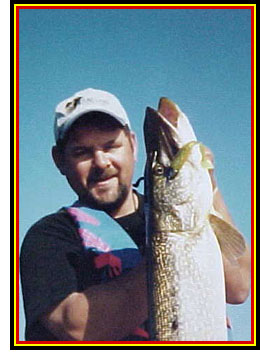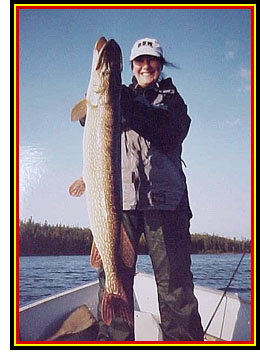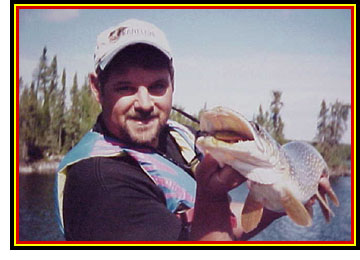
Swimbaits Catch Goliath Mid-Summer Pike
by Jeff Matity

Introduction:
Every species of fish seems to have its dedicated legions of anglers chasing it
with their own specialized gear and techniques. I admit, growing up I focused on
the presentation portion of the fishing equation far more than anything else. I
also admit, I own hundreds, if not thousands, of dollars worth of gear and
tackle I may never use!
The last eighteen years has taught me some simple truths about trophy pike
hunting. Time and money spent learning and doing the leg-work to understand my
quarry, identify quality places is far more important than owning a whole tackle
shop full of specialty lures. I am also starting to pack fewer, yet more
reliable baits for each safari into "gator country". In fact, there are only a
few categories of baits any angler needs to catch trophy fish all over the
world. Swimbaits belong in a class all their own!
This became apparent to me 4 years ago when confronted with the new experience
of fishing largemouth bass in Mexico. I did my homework to identify the location
for big bass but had never really fished them before! I went to the tackle shop
and perused the mind-boggling variety of hardware and baits. It would seem I was
transported back to my childhood as I picked up the prettiest imitation of a
rainbow trout jig I had ever seen! In all fairness, I did at least know bass are
carnivores and eat fish. They also ate that rubber minnow! I couldn't wait to
fish it in northern Saskatchewan; the place where I holiday and guide for pike
in the summer!
The Hunt for Big Pike:
 A quality, portable
fishfinder and polarized glasses are two pieces of equipment that are often
overlooked but, I feel mandatory on any pike water. These along with topo-maps
of the lake will help you eliminate at least 90% of unproductive water. Look on
the map for spawning bays, preferably with incoming creeks or ones draining
large swampy areas of "moose pasture". These warm water areas will be where the
fish will begin their open water season in May. If it is a very cool year you
should actually begin your summer pike search inside each bay and systematically
work your way out. First, search out deeper, crispy-green cabbage weeds at least
6 to 8 feet deep in the heart of the bay. Then explore 10 to 15 foot depths at
the mouth of the bay. Again, look for cabbage if you can find it. Next, move to
shoreline points, narrows and islands closest to the bay. Again, if you can find
good weeds on these spots they will be dynamite! Work each of these from shore
to the 15 foot level. After that, all bets are off. You may have to power-troll
baits to cover the water necessary to find fish. This can often be the case in
July and late September. However, as mentioned above, in the North Country,
August finds concentrations of fish holding in the cabbage beds or around rocky
points closest to the spawning bays.
A quality, portable
fishfinder and polarized glasses are two pieces of equipment that are often
overlooked but, I feel mandatory on any pike water. These along with topo-maps
of the lake will help you eliminate at least 90% of unproductive water. Look on
the map for spawning bays, preferably with incoming creeks or ones draining
large swampy areas of "moose pasture". These warm water areas will be where the
fish will begin their open water season in May. If it is a very cool year you
should actually begin your summer pike search inside each bay and systematically
work your way out. First, search out deeper, crispy-green cabbage weeds at least
6 to 8 feet deep in the heart of the bay. Then explore 10 to 15 foot depths at
the mouth of the bay. Again, look for cabbage if you can find it. Next, move to
shoreline points, narrows and islands closest to the bay. Again, if you can find
good weeds on these spots they will be dynamite! Work each of these from shore
to the 15 foot level. After that, all bets are off. You may have to power-troll
baits to cover the water necessary to find fish. This can often be the case in
July and late September. However, as mentioned above, in the North Country,
August finds concentrations of fish holding in the cabbage beds or around rocky
points closest to the spawning bays.
What's so Special About Cabbage Weed?:
As
in spring, pike are actually quite predictably located in mid-summer. As
stressed above, cabbage patches are the answer when hot, summer sun and goliath
pike enter the equation. The largest pike in the system are available, better
said - vulnerable at this time of year, because of unique characteristics that
define the basic nature of this species.
The heat of the summer sun warms up the shallows which turn from "hotspots" to
"hammer-handle heaven." There are two reasons for this. One is that small
"hammer-handle" pike can tolerate the heat in the shallows while large fish have
been documented to prefer a much lower temperature range. The other reason, and
in my opinion most importantly, is that the forage of small and large pike is
significantly different. Large pike live on larger baitfish and must have
soft-finned prey in the 12"- 24" range in order to reach maximum size.
As schools of suckers complete their spring spawn in the shallows and retreat to
relatively deeper water, their #1 predator follows them. Suckers make a great
living foraging among the stalks and leaves of cabbage weeds during summer.
Without suckers, or other plentiful forage species, in the cabbage there will be
no pike. Therefore, the pike-sucker-cabbage connection is a major predator/prey
relationship in North America. Pike need a feeding strategy they can rely on to
fill their bellies. This is especially true if they are going to reach mammoth
proportions! In mid-summer, their prey is localized and specific.

Use What They Want To Eat: Presentation Will Ultimately Determine Success or Stress!:
A lot of pike anglers rely on spinners (bucktails and tandem-spins) or minnow
baits to fish weeds. They work! I personally do not like using spinners or
multiple treble plugs. Why? I've witnessed too many fish hooked deep on these
baits. If a fish strikes the bait from the side there is usually no problem.
However, if a fish follows the lure, lunges and engulfs the whole thing, the
treble hooks often end up in the gullet or gills. Fish that come in with the
hooks in their lip but are bleeding from the gills were originally hooked in the
gills. The gills tore and the fish is now bleeding out! For this reason,
www.kanelake.com and some other conservation minded outfitters are designating
their top trophy waters as single-barbless hook waters only. Sure, all baits can
have the trebles removed and replaced with a single-barbless hook and, of
course, fish can be hooked deep on single hooks. However, anything that
increases the odds of a clean, live-release is worth trying. There are other
bait options that are just as effective as spinners and more user-friendly to
the fish. In fact, the bait I now use for monster pike is, I think, more
universally effective in fishing all pike situations, spring through fall.
My favorite, bread-and-butter lure for goliath pike is a large swimbait in the
5" to 6.5" range. Big Hammer swimbaits, fished on ½, ¾ or 1oz.
Hammer Heads™, offer the shape, texture, sizes and colors that
combine to create a package that closely imitates the prey big pike feed on.
Namely, long slender fish! Staring through our polarized glasses, we often
observe common white suckers and/or northern hog-nose suckers in the cabbage
beds. To imitate them, colors such as
Baitfish (#13) or Bleeding
Trout (#23)
get the nod. If juvenile lake trout are penetrating the deep edge of the weed bed,
colors such as Krusty Krab (#46) or
Señorita (#64) are
hard to beat. Walleyes will often use the weeds as ambush-feeding sites and pike
will feed on them. If this is the case,
FishChick (#42),
Toast (#20) and
Halloween (#5) are good walleye imitating colors. All good pike guides know
loud, highly visible patterns where fluorescent colors in chartreuse and blaze
orange contrast to make the image really "pop" often trigger the most fish. I
never go piking without some crazy color schemes such as
Atomic Punk (#6),
Margarita (#33) and
Wrathchild (#43).
Regardless of exact color patterns, Big Hammers swim right, pound hard, and draw
a lot of attention. I have compared this bait's action to other swimbaits on the
market and can't get over the difference. Big Hammers literally do swim! As the
unique Square Tail™ beats back and forth the body is thrown into a series of
alternating s-curves. Big Hammer's stiffer, salt-water quality, hand-poured
plastic body absorbs the tail's "hammer-kick". A muscle-like contraction is
conducted down the length of the bait. Anchored by the jig head, the
bait tilts about 45 degrees on its axis, before the next kick sends it rolling
in the opposite direction. The high angle of the roll causes the tapered belly
to flash visibly in either direction.
Many swimbaits on the market swim great but do not hold up to the punishment
pike can dish out! Because of the quality of materials, Big Hammers maintain
their seductive action after as many as 50 fish! You know baits are good when
high-priced guides are spending an hour or so every night with a candle and
paperclip melting and fusing lacerated swimbaits together in order to get a few
more fish out of them! Finally, the money you save fishing swimbaits over high
priced plugs, spinnerbaits and spoons will be enough to cover the deposit on
your next trip. Maybe even your plane ticket! You owe it to yourself the put
this bait in front of a big pike!
Select Swimbait Presentations:
 How can one lure replace so
many tried and true lures and techniques? While a swimbait can not perfectly
imitate the throb of a big blade; the rattle of a jerkbait as its hooks clang
against the body or the flashing, darting action of a spoon, they can be rigged
to possess all of these characteristics. More importantly though, as described
above, they do a pretty dang good job of imitation a baitfish! They can be
fished from top-to-bottom, fast or slow, smooth or erratic and with basic bass
flippin' gear.
How can one lure replace so
many tried and true lures and techniques? While a swimbait can not perfectly
imitate the throb of a big blade; the rattle of a jerkbait as its hooks clang
against the body or the flashing, darting action of a spoon, they can be rigged
to possess all of these characteristics. More importantly though, as described
above, they do a pretty dang good job of imitation a baitfish! They can be
fished from top-to-bottom, fast or slow, smooth or erratic and with basic bass
flippin' gear.
I fish my baits on 20 to 30 pound fused braid. They're all good! My stick of
choice is a high-modulus graphite heavy flippin' stick. I make my own 30 pound
test, black, nylon coated leaders that are 12 inches long and have the jig heads directly attached to the leader. I don't trust snaps! You can buy
leaders, of course. Get black, 12 inch long leaders of, at least, 30 pound test
and squeeze the snaps closed with pliers once you put the jig on. This will save
you a trophy or two over your pikin' career.
When fishing shallows, use lighter heads or fish fast. For medium depths fish
heavier heads fast or lighter heads slow. A swimbait on a jig will work great if
simply cast and retrieved. However, you can get noticed by a lot more fish is
you fish the bait like a jerkbait with quick snaps, long sweeps or a combination
of both. Experience is the best teacher. Get on the water and start chucking
swimbaits! You will come up with a successful retrieve in no time. Don't forget
to give your bait a short "figure-8" or "dying-minnow" free fall at boat side.
Also, goliath pike love to follow hooked fish and can often be converted into
double headers by conscientious anglers paying attention for these dark, ominous
shadows and finessing swimbaits near them.
One thing must be kept in mind when setting the hook on a pike. Pike have
piercing, prey crippling jaw teeth. When they give your bait the crushing bite,
they will sink their teeth deeply into the flesh of the bait. When you set the
hook, you will seldom move the bait and bury the hooks. You need to keep
hook-setting pressure on the fish until it opens its mouth a bit. If you set
hard and then reel down on the fish to gain control, you will often lose the
fish as it gets enough slack to spit the hook. Give the fish the old
one-two-three stabbing hook set. This is the best way I have found to
consistently get good hooks into the fish.
Details, Details!:
Details, dedication and quality equipment are what separate a successful trip of a lifetime from a disappointing, frustrating waste of money and time. Keep your eyes open, your mind focused and fish the places big pike live. Use the right equipment and techniques. Your trip of a lifetime can actually be an annual event to look forward to over and over again! Big pike are rare and are a valuable resource. Let'em go; let'em grow! Make sure you take a camera and send in your pictures!
|
||
![]()
Big Hammer™, Hammer Swimbaits™, Square Tail™, Rectangular Tail™, Square Tail Design™, Rectangular Tail Design™ and the rectangular shaped swimbait tail design are all trademarks owned by Sunrize Tackle, Inc. (parent company of Big Hammer Lures). Use of these terms without written permission by Sunrize Tackle, Inc. is prohibited by law.
The photos, images, text and content of the Big Hammer™ website are copyrighted. These items and information are provided for your convenience and are only intended to be used in the positive promotion and sale of Big Hammer™ products. All other use is prohibited by law.
Big Hammer products are not intended to be used by children under 13 unless accompanied by an adult.
© Copyright Sunrize Tackle, Inc. - All Rights Reserved.